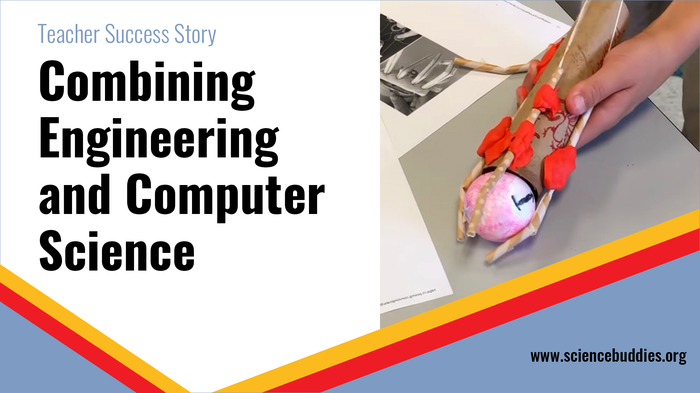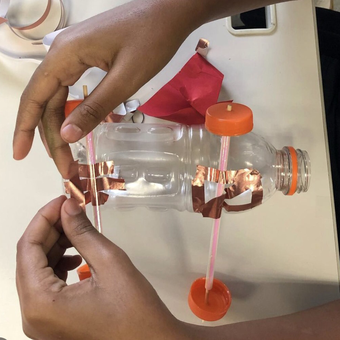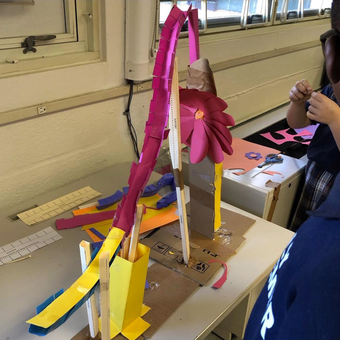Teacher Combines Computer Science and Engineering Design for Middle School Students
This STEM teacher gave students in grades 6, 7, and 8 each a different challenge to explore engineering design and computer science with real-world context.

Engaging Students with Engineering Design and Computer Science
Teaching students the engineering design process helps them understand a model of designing, building, testing, and iterating that they can use to approach problems or to innovate and invent new things. When engineering design is contextualized with real-world examples students are familiar with and can relate to, they can see the applicability of engineering design and its relationship to other STEM fields. Connecting engineering design to programming and computer science gives students the opportunity to explore design, iteration, computational, and algorithmic thinking in exciting and creative ways.
A STEM Challenge for Each Grade
Marianne Green teaches Computer Science to grades 2-8 at Holy Redeemer Catholic School in Kensington, MD. When photos and videos of her students in various stages of building and testing innovative robot hands, looping paper roller coasters, and speedy balloon-powered cars started showing up in social media, we followed up to learn more about how Marianne was using these resources.
What grade(s) did you do these projects with?
"For these recent STEM projects, I worked specifically with the middle school students, who then shared their final product with our elementary students. The sixth graders designed and built the paper roller coasters. The seventh graders built and raced balloon-powered cars, and the eighth graders learned about how computer science contributes to the biomedical field before designing and testing robot hands."


Were these projects for a specific event or exhibition? Or were they part of an extended engineering design exploration with each grade in your Computer Science class?
"I link these activities to computer science topics such as troubleshooting, computational thinking, collaboration, creativity, etc. Specifically, I showcase how technology enhances mechanical, civil, and biomedical engineering products. These activities are also a way for me to connect younger computer science learners with my older students. Community building is the best!"
How did you integrate computer science and computational thinking with these projects?
"For 6th grade, the paper roller coaster activity kicked off a 'Creative Communicator' unit in Computer Science since they focus on designing a paper coaster to introduce the engineering design process to younger learners for the first time. For 7th grade, the balloon cars kicked off a 'Computational Thinker' unit, where they explain to my first graders troubleshooting, critical thinking, etc., in the engineering design process. For 8th grade, the 'Robot Hand' activity was a follow-up activity to learning how to use Tinkercad's 3D platform. Combining how 3D designs connect with bioengineering, specifically with prosthetics, was the main intention of this project."
How did you work these projects into your teaching schedule?
"Students worked in small groups on these projects, and they focused on them from reviewing the engineering design process to testing/evaluating builds for a total of four to five class sessions. Since I only meet with these middle school grade levels twice a week for a total of 80 minutes, selecting engaging but not too challenging STEM activities is essential."
It looks like things went well with all of the projects! If this is the first time you’ve chosen these specific engineering design activities, will you go back to them in the future?
"I have used the paper roller coasters for the past two years, and I plan to use the other two with minor modifications in the future."
Try It with Your Students!
To do these lessons and STEM projects with your students, see the resources below:
- Balloon Car Lesson Plan
- Paper Roller Coasters: Kinetic and Potential Energy
- Grasping with Straws: Make a Robot Hand Using Drinking Straws
For more lessons, activities, and experiments related to the teaching engineering design, potential and kinetic energy, and computer science, see the following resource collections:
- 4 Ways to Teach Engineering Design
- 13 Activities and Lessons to Teach Potential and Kinetic Energy
- 25+ Coding Projects for Beginners and Beyond
- Introduction to Arduino
Thank you to Marianne for sharing her story with Science Buddies.
"Since I only meet with these middle school grade levels twice a week for a total of 80 minutes, selecting engaging but not too challenging STEM activities is essential."
Marianne Green, Teacher
Categories:
You Might Also Enjoy These Related Posts:
- Making Recycling Sorting Machines—STEM Success
- Mini Trebuchets and a NM MESA Challenge
- Helping Students Build Coding Skills with Drones and Self-Driving Cars
- Middle School Student Codes to Improve Life with Visual Impairment
- Student Science Project - Designing and Coding a Video Game to Help People with Alzheimer's
- Teacher Combines Computer Science and Engineering Design for Middle School Students - STEM Success Story
- A Mirror Maze Success Story
- Paper Roller Coasters and Energy Transformation: STEM Teacher Success Story









